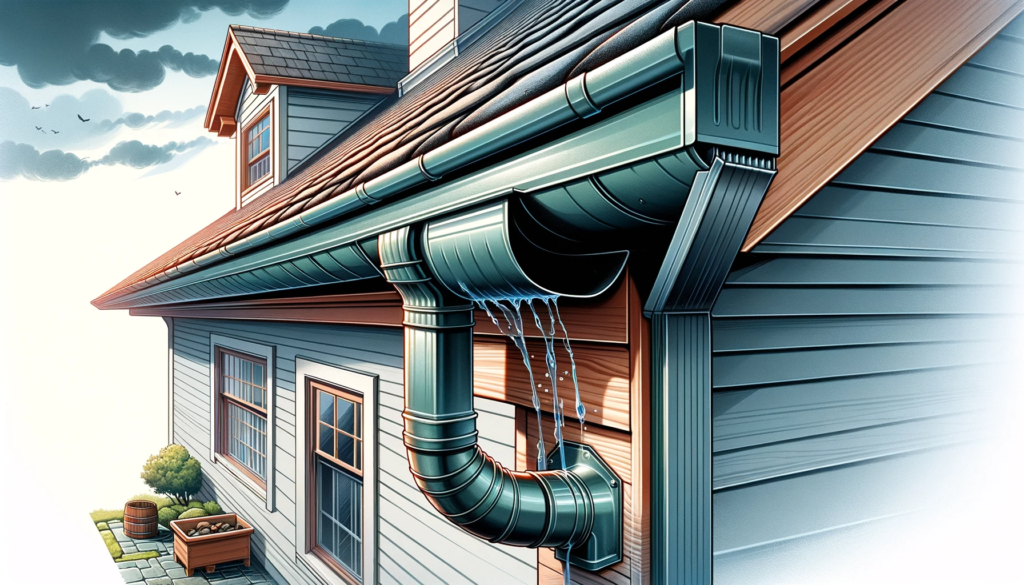Introduction to Gutter and Downspout Drainage

Introduction to Gutter and Downspout Drainage
When we talk about maintaining a home, often the focus is on the interior or the exterior appeal, but what’s running alongside your roof—the gutters and downspouts—are equally critical. As a homeowner, I understand the challenges of managing gutter and downspout drainage; it’s not exactly the most exciting aspect of home care, yet its importance cannot be overstated. This article is designed to offer you practical and actionable tips to ensure your gutter system functions optimally, thereby protecting your home from water damage.
Gutters and downspouts form a key part of your home’s drainage system. They channel rainwater away from your home’s foundation, siding, and landscaping, preventing potential problems like soil erosion, basement flooding, and mold growth. It’s essential to ensure proper installation and maintenance to avoid these issues. I’ve learned that a little attention to your gutter system can save you a lot of time and money in the long run.
Learn more about maintaining your home’s foundation with our insightful guide on Drainage and Foundation Health.
Importance of Proper Gutter Maintenance
Regular gutter maintenance is indispensable; I’ve made it part of my routine home maintenance checklist, and it has paid off. Without proper care, gutters can become clogged with leaves, twigs, and debris, leading to a multitude of problems. If water can’t flow smoothly through the gutters, it will overflow, potentially causing water issues at the foundation of your house or in your basement—exactly what you want to avoid.
The first step in maintaining your gutter system is to clean them regularly—at least twice a year, typically in the spring and fall. This prevents clogging and ensures water flows freely. Additionally, you should inspect your gutters, checking for signs of wear, like rust, holes, or sealant failures. Timely repairs or replacements can prevent minor issues from escalating into major complications.
| Gutter Maintenance Tasks | Frequency | Benefit |
|---|---|---|
| Gutter Cleaning | At least twice a year | Prevents clogging |
| Inspection for Damage | During routine cleaning | Identifies issues early |
| Repair and Replacement | As needed based on inspection | Prevents extensive damage |
Explore our tips for maintaining a healthy drainage system in Drain Maintenance Tips.
Gutter Cleaning Techniques
Cleaning gutters can be a dirty job, but I’ve discovered some efficacious techniques that make the process smoother. First and foremost, safety is paramount. I always ensure to have a sturdy ladder and to wear gloves to protect my hands from sharp objects. A garden trowel or a specialized gutter cleaning tool can be invaluable for scooping out the gunk, and a bucket hooked to the ladder keeps debris contained.
Once the larger debris is removed, a high-pressure hose can flush out the smaller particles. For stubborn areas, a plumber’s snake comes in handy. It’s worth mentioning that some gutter guards or covers can greatly reduce the amount of debris that collects, which I have found to be a worthwhile investment.
- Safety Tips:
- Use a stable ladder.
- Wear gloves and eye protection.
- Cleaning Tools:
- Garden trowel or gutter scoop.
- Hose with high-pressure nozzle.
- Additional Techniques:
- Use a plumber’s snake for clogs.
- Consider installing gutter guards.
For more comprehensive information on drain upkeep, check out Drain Maintenance Safety.
Installing Downspout Extensions
Sometimes, even clean and well-maintained gutters aren’t enough if the water isn’t being directed far enough away from the foundation. This is where downspout extensions come into play. My experience with downspout extensions has shown me that they’re not only practical but easy to install. By attaching these simple devices, I can ensure that water is discharged at a safe distance from my home’s foundation, thus preventing soil erosion and foundation water damage.
There are various types of downspout extensions available, ranging from roll-out sleeves that extend when it rains, to rigid piping that can be buried underground. The key is to choose an option that suits your property’s layout and your own aesthetic preferences.
- Types of Downspout Extensions:
- Roll-out downspout sleeves.
- Rigid, corrugated extenders.
- Decorative downspout splash blocks.
- Installation Tips:
- Measure the necessary distance from your home.
- Choose an extension type that blends with your home’s exterior.
- Ensure a downward slope away from the foundation.
Delve into the details of DIY installations with our guide on DIY Drain Installation.
Addressing Common Drain Problems
Through my journey as a homeowner, I’ve encountered my share of common drain issues. One prevalent problem is clogging, which can often be resolved with regular gutter cleaning. However, when clogs are persistent, it’s important to investigate further, as there might be a deeper issue, such as incorrect gutter slope or inadequate downspout size.
Another issue that’s come up is the improper drainage around the home, which can result from insufficient slope away from the foundation or landscape features directing water towards the house. Solutions can include re-grading the land or installing catch basins and French drains. I always recommend addressing these issues promptly to safeguard your home’s foundation and basement.
- Common Issues and Solutions:
- Clogs – Regular cleaning and checking for adequate gutter slope.
- Water pooling – Ensure proper land grading and consider additional drainage solutions.
- Proactive Measures:
- Install gutter guards to reduce debris accumulation.
- Regularly inspect the entire drainage system for efficiency.
If you’ve faced persistent issues, our article on Common Drain Problems provides further insight.
Tips for Seasonal Drainage Care
With the changing seasons, gutter and downspout maintenance needs can vary. In the spring, I focus on clearing out the debris that has accumulated over the winter, and in the fall, I ensure that leaves do not clog my gutters before the rainy season begins. It’s also important to check the gutters after severe weather events, as storms can bring down branches that may damage the gutter system or block water flow.
In winter, especially in cold climates, preventing ice dams is imperative. This can involve installing heating elements or making sure that the attic is well-insulated to prevent uneven melting of snow on the roof. For those living in areas with high rainfall, making sure to secure any loose gutter parts before the rainy season is critical.
- Seasonal Check-List:
- Spring: Post-winter clean-up.
- Fall: Leaf protection preparation.
- Post-storm: Inspection and repair any damage.
- Winter Tips:
- Prevent ice dams with proper insulation.
- Consider heating elements for gutters in cold climates.
Gain more seasonal advice from our extensive guide on Seasonal Drainage Care.
Drainage Solutions for Landscaping
Adopting drainage solutions within landscaping doesn’t just prevent potential damage; it can also add to the beauty and functionality of your outdoor space. Through my landscaping adventures, I’ve appreciated how features such as a dry creek bed or rain gardens harmoniously integrate with the garden, while also serving a practical purpose of guiding excess water away from the home.
In areas where heavy rains are a norm, incorporating pervious paving materials for walkways and patries allows for better absorption into the ground, reducing runoff. Also, strategically placed rain barrels can serve as a water conservation method, collecting runoff for garden use. It’s essential to choose plants that are native to your region and tolerant of your yard’s moisture conditions for successful landscaping.
- Landscaping Drainage Solutions:
- Dry creek beds for runoff redirection.
- Rain gardens for absorption and beauty.
- Pervious paving materials for reduced runoff.
- Extra Tips:
- Use rain barrels to conserve and utilize rainwater.
- Select native plants suited to moisture levels.
To better understand the integration of landscaping and drainage systems, check out Landscaping and Drainage.
Conclusion: Elevating Home Drainage Systems
Incorporating these gutter and downspout drainage tips into your home maintenance routine will not only elevate your home’s functionality but also its value. Maintaining a robust gutter system ensures peace of mind during heavy rains and protects your home from the many issues that water infiltration can cause. By taking a proactive approach to gutter maintenance, addressing common drainage problems, embracing seasonal care, and integrating drainage into your landscaping, you’re investing in the longevity and health of your home.
It’s comforting to know that by being vigilant with routine care and adopting innovative drainage solutions, we can effectively prevent potential problems. I encourage fellow homeowners to see gutters and downspouts as more than mere accessories; they are integral components that shield our homes from water-related damage. So, let’s give them the attention they deserve and enjoy the benefits of a well-managed drainage system.
Thinking about your home’s value? Read more about how effective drainage can positively impact it in Drainage Home Value.




